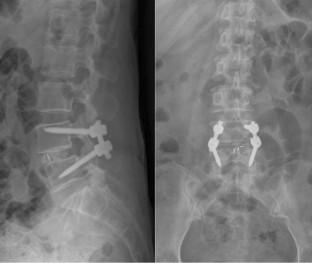European Spine Journal ( IF 2.8 ) Pub Date : 2022-09-29 , DOI: 10.1007/s00586-022-07373-x Shaofeng Chen 1 , Bo Li 1 , Shu Liu 1 , Jian Zhao 2 , Xiaoyi Zhou 1 , Xiao Zhai 1 , Xiaochuan Gu 1 , Canglong Hou 1 , Zhicai Shi 1 , Yushu Bai 1 , Ming Li 1 , Ningfang Mao 1

|
Purpose
The short rod technique (SRT) is a novel method for lumbar pedicle screw placement to reduce surgical trauma and avoid damage to the facet joint and articular surface. The core concept is to change the entry point and angle of the screw on the vertebrae at both ends in the sagittal plane to shorten the length of the longitudinal rods. The purpose of this study is to determine the sagittal screw angle (SSA) and its safe Maximum (MAX) value on each lumbar vertebra for the SRT and to observe the shortening effect on the longitudinal rods.
Methods
A total of 152 healthy adults were investigated by measuring the lumbar spine lateral view images. The SSA and MAX-SSA were measured with SRT as reference to the conventional placement technique method. The distance between the entry points of the proximal and distal vertebrae was measured to compare the changes in the length of the longitudinal rods using the two screw placement techniques.
Results
+ SSA increased from L1 to L4, and −SSA increased from L2 to L5, in which the −SSA of L2, L3, and L4 were significantly greater than those of + SSA (P < 0.05). + MAX-SSA at L1–L4 was 23.26 ± 3.54°, 23.68 ± 3.37°, 24.12 ± 3.29°, and 24.26 ± 3.42°, respectively. −MAX-SSA at L2–L5 was 36.25 ± 3.26°, 38.26 ± 3.73°, 38.62 ± 3.63° and 37.33 ± 3.31°, respectively. Theoretical reductions by calculation for the 2-segment lumbar pedicles were: L1–2: 9 mm, L2–3: 9.29 mm, L3–4: 6.23 mm, and L4–5: 7.08 mm; And the 3-segment lumbar pedicles were: L1–3: 16.97 mm, L2–4: 16.73 mm, L3–5, and 18.24 mm, respectively.
Conclusions
The application of the SRT to lumbar pedicles is a safe screw placement method that can significantly shorten the length of the used longitudinal rods.
中文翻译:

短棒技术腰椎矢状位影像学研究
目的
短杆技术(SRT)是一种新的腰椎椎弓根螺钉置入方法,可减少手术创伤,避免损伤小关节和关节面。其核心理念是在矢状面改变两端椎骨上螺钉的进入点和角度,以缩短纵向杆的长度。本研究的目的是确定 SRT 的每个腰椎的矢状螺钉角度 (SSA) 及其安全最大值 (MAX),并观察对纵向杆的缩短效果。
方法
通过测量腰椎侧视图图像,对总共 152 名健康成年人进行了调查。SSA 和 MAX-SSA 是使用 SRT 测量的,作为传统放置技术方法的参考。测量近端和远端椎骨的入口点之间的距离,以比较使用两种螺钉放置技术的纵向杆长度的变化。
结果
+ SSA从L1增加到L4,-SSA从L2增加到L5,其中L2、L3、L4的-SSA显着大于+SSA(P < 0.05)。+ L1–L4 的 MAX-SSA 分别为 23.26 ± 3.54°、23.68 ± 3.37°、24.12 ± 3.29° 和 24.26 ± 3.42°。−L2–L5 的 MAX-SSA 分别为 36.25 ± 3.26°、38.26 ± 3.73°、38.62 ± 3.63° 和 37.33 ± 3.31°。通过计算 2 节段腰椎椎弓根的理论减少量为:L1-2:9 毫米,L2-3:9.29 毫米,L3-4:6.23 毫米,L4-5:7.08 毫米;3段腰椎椎弓根分别为:L1-3:16.97 mm,L2-4:16.73 mm,L3-5和18.24 mm。
结论
将SRT应用于腰椎椎弓根是一种安全的螺钉置入方法,可以显着缩短所用纵杆的长度。



























 京公网安备 11010802027423号
京公网安备 11010802027423号